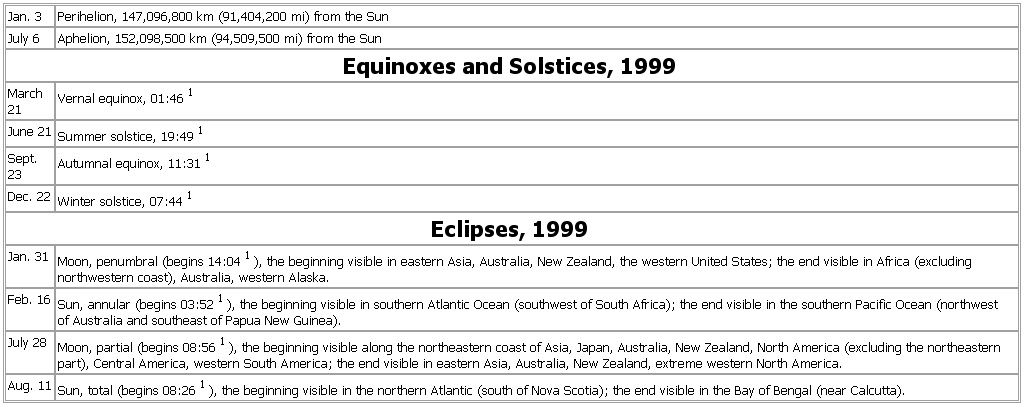Earth Perihelion and Aphelion, 1999
- Earth Perihelion and Aphelion, 1999
-
▪ 1999
Earth Perihelion and Aphelion, 1999
Jan. 3 Perihelion, 147,096,800 km (91,404,200 mi) from the Sun
July 6 Aphelion, 152,098,500 km (94,509,500 mi) from the Sun
Equinoxes and Solstices, 1999
March 21 Vernal equinox, 01:461
June 21 Summer solstice, 19:491
Sept. 23 Autumnal equinox, 11:311
Dec. 22 Winter solstice, 07:441
Eclipses, 1999
Jan.
31 Moon,
penumbral (
begins 14:041),
the beginning visible in eastern Asia,
Australia,
New Zealand,
the western United States;
the end visible in Africa (
excluding northwestern coast),
Australia,
western Alaska.
Feb. 16 Sun, annular (begins 03:521), the beginning visible in southern Atlantic Ocean (southwest of South Africa); the end visible in the southern Pacific Ocean (northwest of Australia and southeast of Papua New Guinea).
July 28 Moon,
partial (
begins 08:561),
the beginning visible along the northeastern coast of Asia,
Japan,
Australia,
New Zealand,
North America (
excluding the northeastern part),
Central America,
western South America;
the end visible in eastern Asia,
Australia,
New Zealand,
extreme western North America.
Aug. 11 Sun, total (begins 08:261), the beginning visible in the northern Atlantic (south of Nova Scotia); the end visible in the Bay of Bengal (near Calcutta).
See as table:
1Universal time.
Source: The Astronomical Almanac for the Year 1999 (1998).
* * *
Universalium.
2010.
Look at other dictionaries:
Earth Perihelion and Aphelion, 2000 — ▪ 2000 Earth Perihelion and Aphelion, 2000 Jan. 3 Perihelion, 147,102,800 km (91,405,443 mi) from the Sun July 4 Aphelion, 152,102,300 km (94,511,989 mi) from the Sun Equinoxes and Solstices, 2000 March 20 Vernal equinox, 07:351 June 21 Summer… … Universalium
Mathematics and Physical Sciences — ▪ 2003 Introduction Mathematics Mathematics in 2002 was marked by two discoveries in number theory. The first may have practical implications; the second satisfied a 150 year old curiosity. Computer scientist Manindra Agrawal of the… … Universalium
Earth — This article is about the planet. For other uses, see Earth (disambiguation). Earth … Wikipedia
Near-Earth object — Asteroid 4179 Toutatis is a potentially hazardous object that has passed within 2.3 lunar distances … Wikipedia
(53319) 1999 JM8 — Infobox Planet | discovery=yes | physical characteristics = yes | bgcolour=#FFFFC0 name=mp|(53319) 1999 JM|8 discoverer= LINEAR discovered=May 13, 1999 alt names=mp|1990 HD|1 mp category=near Earth, Mars crosser epoch=December 1, 2005 (JD 2453705 … Wikipedia
Physical Sciences — ▪ 2009 Introduction Scientists discovered a new family of superconducting materials and obtained unique images of individual hydrogen atoms and of a multiple exoplanet system. Europe completed the Large Hadron Collider, and China and India took… … Universalium
(101955) 1999 RQ36 — Radar image of 1999 RQ36, courtesy Arecibo Observatory and JPL.[1][2] … Wikipedia
(137108) 1999 AN10 — Infobox Planet minorplanet = yes width = 25em bgcolour = #FFFFC0 name = mp|(137108) 1999 AN|10 symbol = caption = discovery = yes discovery ref = discoverer = LINEAR discovered = January 13 1999 designations = yes mp name = mp|(137108) 1999 AN|10 … Wikipedia
Sun — This article is about the star. For other uses, see Sun (disambiguation). The Sun … Wikipedia
Jupiter — This article is about the planet. For other uses, see Jupiter (disambiguation). Jupiter … Wikipedia
 1Universal time.Source: The Astronomical Almanac for the Year 1999 (1998).
1Universal time.Source: The Astronomical Almanac for the Year 1999 (1998).